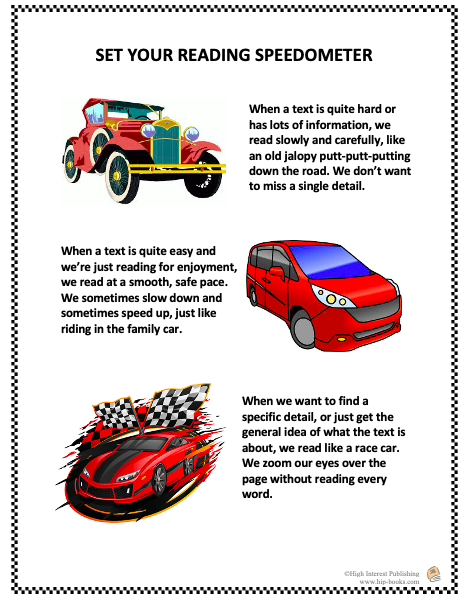Different Reading Speeds for Different Purposes
Most of our struggling readers – and many independent readers as well – need instruction and guided practice in adjusting reading rates for different purposes.
When a text is challenging or dense with information that must be learned or remembered, we need to read very slowly and deliberately.
When we’re reading for pleasure or recreation, and the text is quite easy, we cruise through the text at a smooth speed, pausing or rereading as necessary.
When we’re skimming for the gist of the text or scanning for a specific detail, we zoom through the text, running our eyes quickly over the page without reading every word. The lesson below guides students in skimming or scanning like a race car.
The anchor chart on the left provides an analogy between adjusting reading rates and driving different types of cars. Click on the image to enlarge it.
Skim, Scan or Skip?
Learning Goal: Students will be able to use skimming and scanning and judge when each is appropriate to use.
When we want to get a sense of what a passage is about, we often skim a page or two to get the gist of the text. When we want to find a specific detail, we scan the page to search for a key word. Both processes involve reading like a race car, running our eyes quickly over the page without focusing on individual words. Sometimes it’s okay to skip entire chunks of text if it doesn’t meet our purposes or provide the information we need.
Scanning for specific details: Use enlarged text on a screen or chart to model fast reading by running your finger down the page and targeting a specific word. Then give students practice by asking specific questions for them to answer by scanning for answers. Talk about choosing one or two key words to focus on. You can turn it into a contest by having students compete to see how quickly they locate the required information.
Skimming for an overview: To practise skimming, have the students to read a section of text quickly, running eyes down the page much like scanning, but this time to get the gist of the passage rather than to look for specific information. Talk with the students about when to use skimming – to see if this text will be useful for our purposes, for example, or to decide whether or not we’ll be interested in reading on. Skimming might be used for before-reading – to establish a context for later close reading – or for after-reading, as a quick review. Use enlarged print on a screen to display the text briefly, then remove it while students summarize what they read with a partner. Gradually increase the amount of print for students to skim (remembering that readers rarely skim more than a page or so at a time).
|
Tips for skimming include: · Read the title and introduction. · Read the opening sentence of each paragraph. · Look at any subheadings. · Attend to signals of importance such as italics or boldface. |
Must-do Practice: Have students practice scanning by providing a series of short-answer questions for students to respond to within a limited time frame. Practice skimming in partners by having the pairs skim the same section of text and then compare notes on their impressions of the text.


